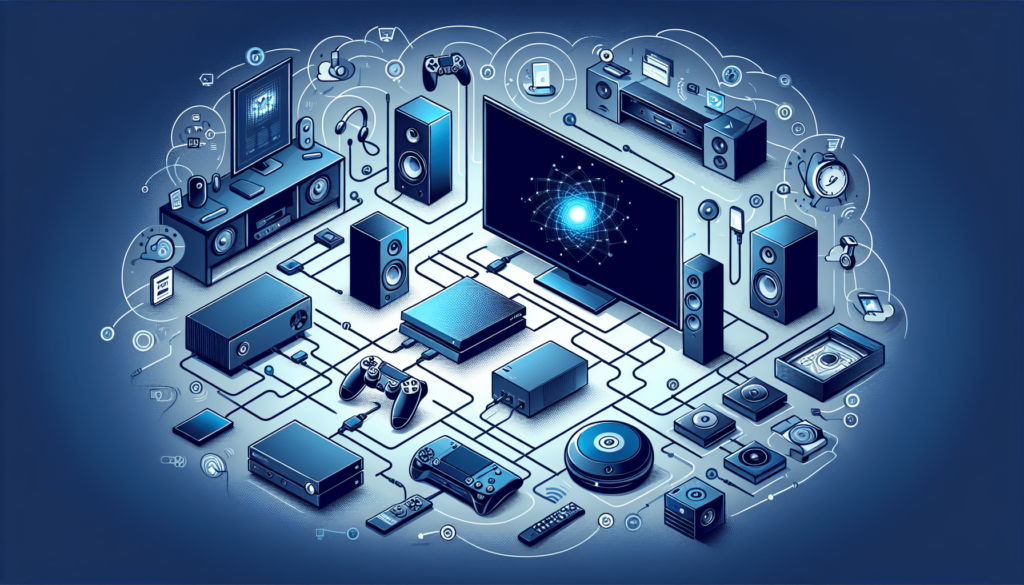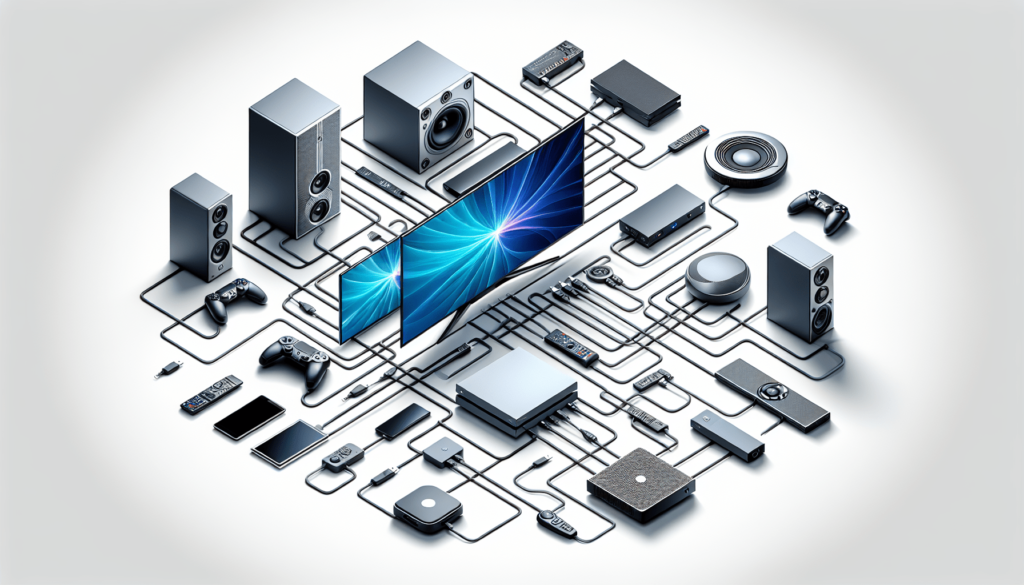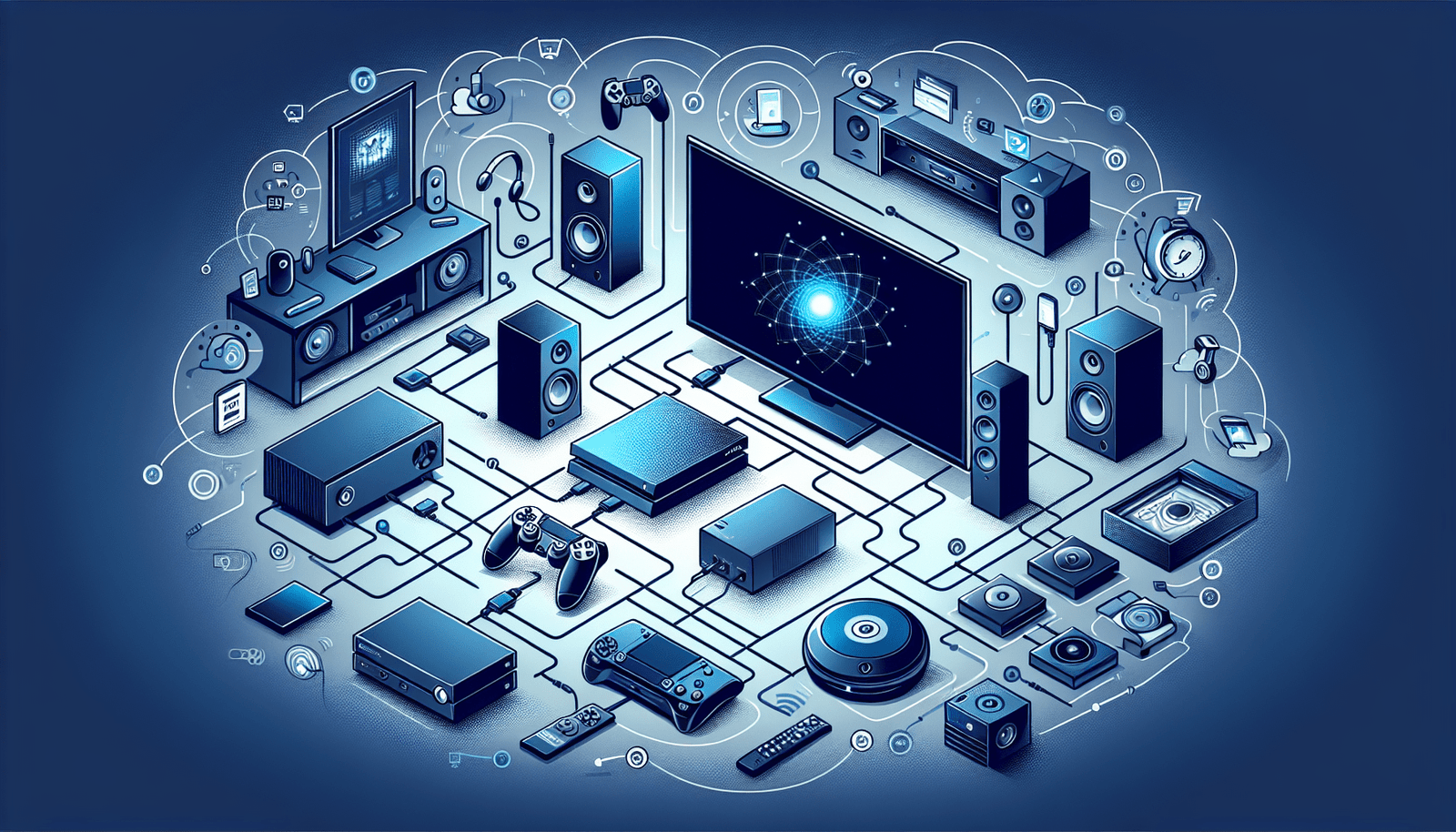Imagine having the ability to seamlessly connect all of your favorite devices to your home entertainment system. No more juggling different remotes or struggling to find the right settings for each device. In this article, we will show you the simple steps that will allow you to connect your home entertainment system to multiple devices effortlessly. Whether you want to stream movies from your laptop, play video games on your console, or listen to music from your smartphone, we have got you covered. Get ready to transform your living room into the ultimate entertainment hub.

Determine the Hub for Connectivity
Choose a central hub
To connect multiple devices in your home entertainment system, it’s crucial to choose a central hub that can serve as the main point of connectivity. This hub will allow you to consolidate and control all your devices from a single location, making it easier to navigate and manage your home entertainment setup.
Consider smart home devices as hubs
If you have smart home devices already in your home, such as a smart speaker or a smart TV, consider utilizing them as hubs for your entertainment system. These devices often come with built-in connectivity options, allowing you to connect and control other devices seamlessly.
Evaluate compatibility with existing devices
Before finalizing your central hub choice, it’s important to evaluate its compatibility with your existing devices. Ensure that the hub supports the necessary connections and protocols required by your devices. Compatibility will guarantee smooth integration and optimal functionality for your entertainment system.
Understanding Wired Connections
Use HDMI cables
HDMI cables are a popular choice for connecting various devices in your home entertainment system. These cables transmit both high-definition video and audio signals, providing a seamless and high-quality experience. Simply connect the HDMI cable from your source device, such as a Blu-ray player or gaming console, to your TV or audio receiver.
Utilize component video cables
If you have older devices that don’t support HDMI, component video cables are another option. These cables separate the video signal into different color channels, providing a decent video quality. However, it’s important to note that component video cables only transmit video signals, so you’ll need a separate audio connection.
Consider composite video cables
Composite video cables are the most basic option for connecting devices to your TV. They transmit analog video signals, but the quality is generally lower compared to HDMI or component cables. If you have older devices with composite outputs, you can still use these cables, but keep in mind that the video quality may not be as clear and crisp.
Connect devices using Ethernet cables
To ensure a stable and fast internet connection for streaming and online gaming, use Ethernet cables to connect your devices directly to your router. This wired connection eliminates potential Wi-Fi interference and provides a reliable connection, especially for devices that require a consistent network connection.
Exploring Wireless Options
Setup Wi-Fi connectivity
Wi-Fi connectivity is a convenient option for connecting your devices wirelessly to your home network. Most modern devices, such as smart TVs, streaming devices, and gaming consoles, offer built-in Wi-Fi capabilities. Simply connect to your home Wi-Fi network, enter the password if prompted, and enjoy wireless connectivity throughout your home.
Use Bluetooth technology
Bluetooth technology allows for wireless connections between devices in close proximity. It’s commonly used for connecting speakers, headphones, and smartphones to other devices. If you have Bluetooth-enabled devices in your entertainment system, you can easily pair them and enjoy wireless audio streaming or control.
Consider Wi-Fi Direct
Wi-Fi Direct is a feature that enables direct communication between devices without the need for a traditional Wi-Fi network. This can be beneficial when connecting devices that don’t have built-in Wi-Fi, such as older TVs or audio receivers. By using Wi-Fi Direct, you can establish a direct connection between the devices, allowing for seamless communication and streaming.
Utilize NFC for quick pairing
NFC (Near Field Communication) is a technology that allows for quick and effortless pairing between devices by simply touching them together. If your devices support NFC, you can easily connect them by tapping them together. This makes it convenient to connect your smartphone or tablet to other NFC-enabled devices, such as speakers or headphones.

Setting Up Audio Connections
Use HDMI ARC for audio
HDMI ARC (Audio Return Channel) is a feature that allows you to send audio signals from your TV to an audio receiver or soundbar through an HDMI cable. This eliminates the need for a separate audio connection and simplifies the setup process. Simply connect one end of the HDMI cable to the ARC-enabled HDMI port on your TV and the other end to the ARC-enabled port on your audio receiver or soundbar.
Connect devices using digital optical audio
Digital optical audio connections, also known as TOSLINK connections, transmit audio signals using light. This connection is commonly found on TVs, audio receivers, and soundbars. By using a digital optical cable, you can connect your devices and enjoy high-quality audio without any loss in sound quality.
Utilize RCA audio cables
RCA audio cables are the classic red and white cables used to connect audio devices. While not as common as HDMI or optical connections, they are still widely used, especially for older devices. Simply connect the corresponding colors on the cables to the audio outputs of your devices and then connect the other end to your audio receiver or soundbar.
Consider analog 3.5mm audio connections
Analog 3.5mm audio connections, also known as headphone jacks, are commonly found on smartphones, tablets, and computers. You can utilize this connection by using a 3.5mm audio cable to connect your device to speakers, soundbars, or headphones. This connection is convenient and allows for easy audio playback without the need for additional adapters or cables.
Configuring Universal Remote Control
Choose a universal remote control
A universal remote control allows you to control multiple devices from a single remote, eliminating the need for separate remotes for each device. When choosing a universal remote, consider the number of devices it can control, the compatibility with your devices, and the ease of setup and configuration.
Set up the remote with device codes
Most universal remote controls require programming with specific device codes to ensure compatibility with your devices. Follow the instructions provided with your remote control to input the corresponding codes for each device. Once programmed, you can use the universal remote to control multiple devices simultaneously.
Configure through mobile apps
Many universal remote controls now have companion mobile apps that provide a user-friendly interface for setup and configuration. These apps often allow you to search for your devices and automatically configure them without the need for manual programming. Additionally, some apps offer advanced features like voice control and personalized settings.
Explore voice-controlled remotes
Voice-controlled remotes, such as those powered by virtual assistants like Amazon Alexa or Google Assistant, provide a hands-free and intuitive way to control your devices. These remotes allow you to simply speak commands, such as “turn on the TV” or “change the channel,” and have them executed effortlessly. Voice control adds an extra level of convenience to your home entertainment system.
Utilizing Network Streaming
Connect smart TVs to the network
Smart TVs are designed to be connected to your home network, allowing you to access online streaming services and other internet-based content. To connect your smart TV, navigate to the network settings menu on your TV’s interface and follow the instructions to connect to your Wi-Fi network or use an Ethernet cable for a wired connection.
Link streaming devices to the network
If you have devices specifically dedicated to streaming, such as media players or streaming sticks, connect them to your network to access various streaming services. Most streaming devices have built-in Wi-Fi capabilities, allowing for easy connection to your network. Simply navigate to the network settings on your device and follow the prompts to connect.
Enable media sharing on computers
If you have media files stored on your computer, you can enable media sharing to stream them directly to your smart TV or other connected devices. This allows you to access your personal media library without the need for additional storage or devices. Check your computer’s settings or install media server software to enable media sharing.
Utilize network-attached storage (NAS)
Network-attached storage (NAS) is a dedicated device that allows you to store and access data over your home network. By connecting a NAS device to your network, you can access your media files, such as movies, music, and photos, from multiple devices within your home. NAS provides a centralized and easily accessible storage solution for your home entertainment system.
Adding Gaming Consoles to the Mix
Connect consoles to the TV
To connect gaming consoles to your TV, use HDMI cables for the best video and audio quality. Most modern consoles, such as PlayStation and Xbox, have HDMI outputs that can be easily connected to an HDMI input on your TV. Ensure that your TV is set to the corresponding HDMI input in order to display the console’s output.
Configure network settings
Gaming consoles often require an internet connection for online gaming, software updates, and access to additional content. Connect your console to your home network either through Wi-Fi or by using an Ethernet cable for a more stable connection. Follow the console’s setup instructions to configure the network settings and enter your Wi-Fi network password if required.
Use HDMI pass-through
Some gaming consoles feature HDMI pass-through functionality, allowing you to connect other devices, such as cable/satellite boxes or streaming devices, to your console. This setup allows you to control both the console and the connected device with a single remote, simplifying your home entertainment experience.
Optimize audio settings
To ensure optimal audio performance while gaming, configure the audio settings on your console. Most gaming consoles offer various audio output options, such as stereo, surround sound, or Dolby Atmos. Choose the appropriate setting based on your audio setup, whether it’s connected to a soundbar, surround sound system, or TV speakers.
Incorporating Mobile Devices
Screen mirroring with devices
Screen mirroring allows you to display the screen of your mobile device, such as a smartphone or tablet, on your TV for a larger viewing experience. If your TV supports screen mirroring, enable the feature and follow the instructions on your mobile device to connect and mirror the screen wirelessly. This is particularly useful for sharing photos, videos, or presentations.
Casting content from smartphones and tablets
Casting allows you to stream content from compatible apps on your smartphone or tablet to your TV or other connected devices. This feature is often supported by devices like Chromecast or smart TVs with built-in casting capabilities. Simply open the desired app, find the cast icon, and select the device you want to cast to for a seamless streaming experience.
Utilize mobile apps as remote controls
Many manufacturers offer companion mobile apps for their entertainment devices, allowing you to control them through your smartphone or tablet. These apps often provide additional features and options not available on physical remote controls. Download the app corresponding to your device and follow the setup instructions to connect and control your devices conveniently.
Connecting through DLNA standards
DLNA (Digital Living Network Alliance) standards enable the seamless sharing of media content between devices on the same network. If your devices support DLNA, you can easily connect and stream media from one device to another, such as playing music from your smartphone on your smart TV. Check your device settings or app capabilities to enable DLNA functionality.
Considerations for Multiroom Audio
Invest in multiroom audio systems
Multiroom audio systems allow you to play synchronized music in different rooms or zones of your home. These systems typically consist of speakers, an audio distribution hub, and control options. Investing in a multiroom audio system provides a seamless and immersive audio experience, allowing you to enjoy music throughout your entire home.
Configure multiroom audio using Wi-Fi
Most multiroom audio systems utilize Wi-Fi connectivity for seamless audio streaming. To configure a multiroom audio system, connect the speakers and control devices to your Wi-Fi network and set up the accompanying mobile or desktop apps. Once configured, you can easily control and stream audio to different speakers or zones within your home.
Use dedicated speakers or soundbars
Some multiroom audio systems offer dedicated speakers or soundbars designed specifically for their systems. These speakers provide optimal audio performance and can be placed strategically within different rooms or zones. By using dedicated speakers, you can ensure consistent audio quality and synchronization throughout your multiroom audio setup.
Explore wireless audio distribution
Wireless audio distribution systems allow you to distribute audio signals wirelessly to multiple speakers or zones within your home. These systems typically require a transmitter connected to your audio source and wireless receivers connected to speakers in each zone. Wireless audio distribution provides flexibility in speaker placement and eliminates the need for extensive wiring.
Troubleshooting and Maintenance
Check cable connections
If you encounter any connectivity issues with your home entertainment system, start by checking all cable connections. Ensure that cables are securely plugged in and that there are no loose connections. Sometimes, a simple reconnection or replacement of a faulty cable can resolve any issues.
Update firmware and software
Regularly updating the firmware and software on your devices is crucial for maintaining optimal performance and compatibility. Check for updates on your devices’ respective manufacturer websites or through their companion apps. These updates often include bug fixes, security enhancements, and new features that can enhance your overall entertainment experience.
Troubleshoot network connectivity
If you’re experiencing network connectivity issues, ensure that your router is functioning correctly and that all network settings are properly configured. Restarting your router, updating its firmware, and ensuring that you have a stable internet connection can often resolve network-related problems. Consult your router’s user manual or contact your internet service provider for further assistance if needed.
Perform regular system maintenance
To keep your home entertainment system running smoothly, perform regular system maintenance. This includes cleaning your devices and their connections, ensuring proper ventilation to prevent overheating, and organizing cables to minimize clutter. By keeping your system clean and well-maintained, you can prolong the lifespan of your devices and maintain optimal performance.
In conclusion, connecting your home entertainment system to multiple devices requires careful consideration of the connectivity options available. Whether you choose wired or wireless connections, it’s important to evaluate compatibility, set up audio connections, configure a universal remote control, utilize network streaming options, incorporate gaming consoles and mobile devices, consider multiroom audio, and perform troubleshooting and maintenance. By following these steps and understanding the various connectivity options, you can create a comprehensive and seamless home entertainment setup that meets all your audiovisual needs.

